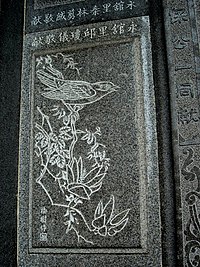
Quick Facts
Biography
Li Mei-shu (Chinese: 李梅樹; pinyin: Li Méishù) (March 13, 1902 – February 6, 1983) was a Taiwanese painter, sculptor, and politician. Born to an upper-class family in Sankakuyū (Pe̍h-ōe-jī: Saⁿ-kak-éng), Japanese Taiwan (modern-day Sanxia District, New Taipei City).
Education
Li Meishu began to demonstrate a propensity for painting in his early years. In 1918, he was accepted into the Painting Division of the Taiwan Governor-General's National Language School. He taught himself painting after school through a copy of A Collection of Lectures, which he acquired from Japanese through post. Upon graduating, he taught at Zuihō Public School (in modern-day Ruifang District). During this time, he participated in the Summer Art Seminar organized by Ishikawa Kinichiro. His works 'Still Life and Backstreets of Sanxia' were selected for the 1st and 2nd Taiwan Art Exhibitions (Taiten), respectively.
He then obtained his family’s consent to go to Japan to further his painting studies. In 1929, he was accepted by the Division of Western Painting at the Tokyo School of Fine Arts, where he learned from teachers such as Okada Saburousuke and Kobayashi Mango.
Work and public life
After graduating in 1934, he returned to Taiwan and co-founded the Tai-Yang Art Society with others - including Liao Chi-chun and Tan Ting-pho - and actively promoted art events. In 1935, his work Girl at Rest was the special selection of the 9th Taiwan Art Exhibition. In 1939, his work Red Dress was selected for the 3rd Ministry of Education Art Exhibition (Shin Bunten). After World War II, the public-minded Li Meishu served several terms as the chairman of Sanxia street, township representative, and county councilor. From 1945, he served as director of the re-construction committee of Qingshui Zushi (Divine Ancestor) Temple in Sanxia. He invited his friends in the art community, such as Chen Jin, Lin Yushan, Guo Xuehu, to draw upon the stone walls and sculptures of Zushi Temple, which made Zushi Temple a collective work of the Taiwanese artists. From 1962, he devoted himself to the promotion of art education by teaching in the art departments of schools such as Chinese Culture University, National Taiwan University of Arts, and National Taiwan Normal University.

Painting style
The subjects of his paintings focus primarily on figures, landscapes, and still lifes in a realist style. Even at a time in the 1950s when abstract art styles were surging, his paintings still remained true to realism. Li’s paintings demonstrated strong local sentiments and his love for portraying local people and culture. His great love for Sanxia has left scenic paintings of Sanxia as Spring Dawn at Sanxia (1977), Washing Clothes in the River (1981). He also loved to use his family members as models for his paintings, and used photographed images to provide an outline or base for his work. Emphasis was put on expressing the characteristics of the people he was painting - the patterns of their clothing and subject’s relationship with the background. His works appeal to laymen as well as scholars.
